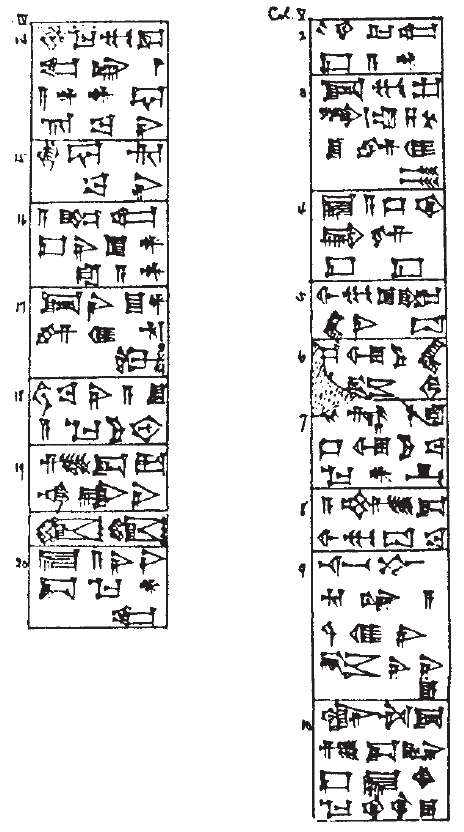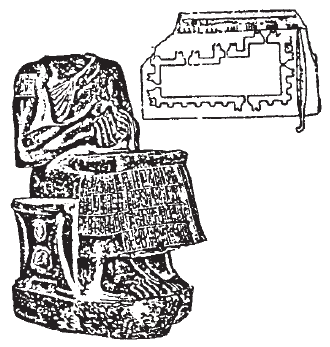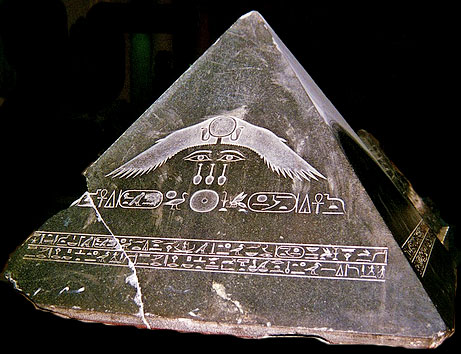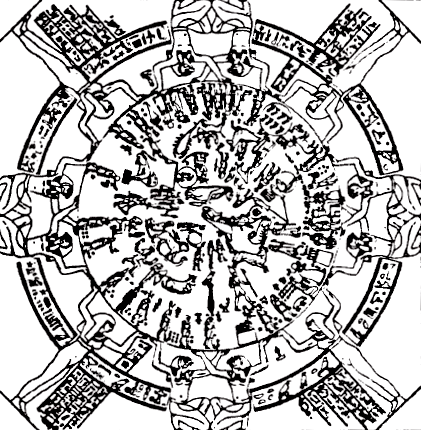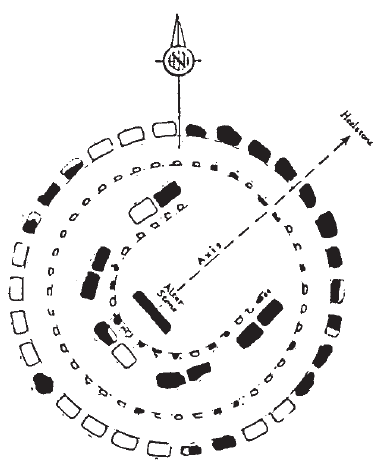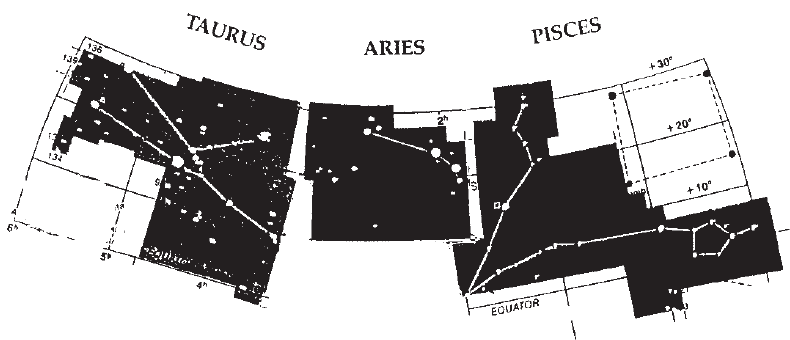|
EGYPTIAN PROPHECIES, HUMAN DESTINIES
Indeed, it was Marduk’s chess-like strategy maneuvers and geographic movements from one place to another that controlled the agenda of the era’s “divine chess game.”
His moves and movements began with a
departure from Egypt, to become (in Egyptian eyes) Amon (also
written Amun or Amen), “The Unseen.”
The famed inscriptions of the Memphite Pharaohs glorified the gods and promised an Afterlife for the kings. Reigning as the gods’ surrogates, those Pharaohs wore the double crown of Upper (southern) and Lower (northern) Egypt, signifying not just the administrative but also the religious unification of the Two Lands, unification attained when Horus defeated Seth in their struggle for the Ptah/Ra legacy.
And then, in 2160 b.c.e., that unity and
religious certainty came crashing down.
A prophetic section describing the
coming of a Redeemer, and another that extolls the ideal times that
will follow, conclude the papyrus.
Though the Nile is in flooding and irrigates the land,
The roads are unsafe, trade has ceased, the provinces of Upper Egypt are no longer taxed;
Some Egyptologists believe that at the core of those events lay a simple rivalry for wealth and power, an attempt (successful in the end) by Theban princes from the south to control and rule the whole country.
Lately, studies have associated the collapse of the Old
Kingdom with a “climate change” that undermined a society founded on
agriculture, caused food shortages and food riots, social upheaval,
and collapse of authority. But little attention has been paid to a
major and perhaps the most important change: in the texts, in the
hymns, in the honorific names of temples, it was no longer Ra but
from then on Ra-Amon, or simply Amon, who was henceforth worshipped;
Ra became Amon—Ra the Unseen—for he was gone from Egypt.
The upheaval began with a collapse of religious observances and manifested itself in the defiling and abandonment of temples, where,
The sacred symbol of the gods worn on the king’s crown, the Uraeus (the Divine Serpent),
After calling on the people to repent, “to offer incense in the temples... to keep the offerings to the gods,” the papyrus called on the repenters to be baptized—to “remember to immerse.”
Then the words of the papyrus turn prophetic: in a passage that even Egyptologists call “truly messianic,” the Admonitions speak of “a time that shall come” when an unnamed Savior—a “god-king”—shall appear.
Those ideal times, Ipu-Wer stated in his prophecy, will be preceded by their own messianic birth pangs:
If not just the description of events and the messianic prophecies, but also the choice of wording in that ancient Egyptian papyrus seem astounding, there is more to come.
Scholars are aware of the existence of another prophetic/ messianic text that reached us from ancient Egypt, but believe that it was really composed after the events and only pretends to be prophetic by dating itself to an earlier time. To be specific, while the text purports to relate prophecies made at the time of Sneferu, a Fourth Dynasty pharaoh (circa 2600 b.c.e.), Egyptologists believe that it was actually written in the time of Amenemhet I of the Twelfth Dynasty (circa 2000 b.c.e.)—after the events that it pretends to prophecy.
Even so,
the “prophecies” serve to confirm those prior occurrences; and many
details and the very wording of the predictions can best be
described as chilling.
Summoned to the king to foretell the future, Nefer-Rohu “stretched forth his hand for the box of writing equipment, he drew forth a scroll of papyrus,” and then began to write what he was envisioning, in a Nostradamus-like manner:
Before Ra can restore the “Foundations of the Earth,” there will be invasions, wars, bloodshed. Then a new era of peace, tranquility, and justice will follow.
It will be brought by what we have come to call a Savior, a Messiah:
It is astounding to find such messianic prophecies of apocalyptic
times and the end of Wrongdoing that will be followed by the
coming—the return—of peace and justice, in papyrus texts written
some 4,200 years ago; it is chilling to find in them terminology
that is familiar from the New Testament, about an Unknown, the
Triumphant Savior, the “Son-Man.”
Ninurta—here called NIN.GIRSU, “Lord of the Girsu”—already had a temple there, as well as a special enclosure for his “Divine Black Bird” or flying machine.
Yet the building of the new temple required special permission from Enlil, which was in time granted. We learn from the inscriptions that the new temple had to have special features linking it to the heavens, enabling certain celestial observations.
To that end Ninurta invited
to Sumer the god Ningishzidda (“Thoth” in Egypt), the Divine
Architect, and Keeper of the Secrets of the Giza pyramids. The fact
that
Ningishzidda/Thoth was the brother whom Marduk forced into
exile circa 3100 b.c.e. was certainly not lost on all concerned...
That special time when the destinies on Earth are determined in the heavens was what we have called Celestial Time, the Zodiacal Clock.
That such determining was linked to Equinox Day becomes evident from the rest of Gudea’s tale, as well as from Thoth’s Egyptian name Tehuti, The Balancer (of day and night) who “Draws the Cord” for orienting a new temple.
Figure 17
Such celestial considerations continued to dominate
the Eninnu project from start to finish.
A third god, Ningishzidda (i.e. Thoth) held a tablet of lapis lazuli on which a
structural plan was drawn; he also held a clay brick, a mold for
brick-making, and a builder’s carrying basket. When Gudea awoke, the
three gods were gone, but the architectural tablet was on his lap
(Fig. 18) and the brick and its mold were at his feet!
In the third vision-dream he was shown a holographic-like animated demonstration of the temple’s building, starting with the initial alignment with the indicated celestial point, the laying of foundations, the molding of bricks—the construction all the way up, step by step.
Both the start of construction and the final dedication ceremony were to be held on signals from the gods on specific days; both fell on New Year’s Day, which meant the day of the Spring Equinox.
Figure 18 The temple “raised its head” in the customary seven stages, but—unusually for the flat-topped Sumerian ziggurats—its head had to be pointed, “shaped like a horn”—Gudea had to emplace upon the temple’s top a capstone!
Its shape is not described, but in all probability (and judging by the image on Nisaba’s head), it was in the shape of a pyramidion—in the manner of capstones on Egyptian pyramids (Fig. 19).
Figure 19
Moreover, rather than leave the brickwork exposed, as was customary, Gudea was required to encase the structure with a casing of reddish stones, increasing its similarity to an Egyptian pyramid.
That raising a structure with the appearance of an Egyptian pyramid had a purpose becomes clear from Ninurta’s own words.
The new temple, he told Gudea, will be seen from afar; its awe-inspiring glance will reach the heavens; the adoration of my temple shall extend to all the lands, its heavenly name will be proclaimed in countries from the ends of the Earth.
Magan and Meluhha were the Sumerian names for Egypt and Nubia, the Two Lands of the gods of Egypt.
The purpose of the Eninnu was to establish, even there, in Marduk’s lands, Ninurta’s unequaled Lordship:
Proclaiming Ninurta’s (rather than Marduk’s) supremacy required special features in the Eninnu. The ziggurat’s entrance had to face the Sun precisely in the east, rather than the customary northeast.
In the temple’s topmost level Gudea had to erect a SHU.GA.LAM—“where the shining is announced, the place of the aperture, the place of determining,” from which Ninurta/Ningirsu could see “the Repetition over the lands.”
It was a circular chamber with twelve positions,
each marked with a zodiacal symbol, with an aperture for observing
the skies—an ancient planetarium aligned to the zodiacal
constellations! In the temple’s forecourt, linked to an avenue that faced sunrise, Gudea had to erect two stone circles, one with six and the other with seven stone pillars, for observing the skies. Since only one avenue is mentioned, one assumes that the circles were one within the other.
As one studies each phrase, terminology, and structural
detail, it becomes evident that what was built in Lagash with the
help of Ningishzidda/Thoth was a complex yet practical stone
observatory, one part of which, devoted entirely to the zodiacs,
reminds one of the similar one found in Denderah, Egypt (Fig. 20),
and the other, geared to observing celestial risings and setting, a
virtual Stonehenge on the banks of the Euphrates river!
Such a sight line, precisely oriented when planned, enabled determining at the moment of heliacal rising in which zodiacal constellation the Sun was appearing. And that—determining the zodiacal age through precise observation—was the prime objective of the whole complex facility.
Figure 21
In Stonehenge, that sight line ran (and still runs) from the stone column called the Altar Stone in the center, through two stone columns identified as Sarsen Stones numbers 1 and 30, then down the Avenue to the so-called Heel Stone (see Fig. 6). It is generally agreed that the Stonehenge with the double Bluestone Circle and the Heel Stone of what is designated Stonehenge II dates to between 2200 to 2100 b.c.e.
That was also the time—perhaps more accurately, in 2160 b.c.e.—when the “Stonehenge on the Euphrates” was built.
They were all deliberate countermoves by Ninurta
and Ningishzidda to Marduk’s Divine Chess Game: to show Mankind that
the zodiacal age was still the Age of the Bull.
Why? Because, he announced, the Age of the Bull, the Age of Enlil, was over; the Age of the Ram, Marduk’s zodiacal age, has
arrived. It was, just as Ninurta had told Gudea, the time when in
the heavens destinies on Earth were determined.
Since the Deluge
occurred, according to Sumerian texts, in the Age of the Lion, our
zodiacal clock can start circa 10860 b.c.e.
Setting aside the neat end result that synchronizes with the Christian Era, one must wonder whether it was mere coincidence that the Ishtar-Ninurta era petered out in or about 2160 b.c.e., just when, according to the above zodiacal calendar, the Age of the Bull, Enlil’s Age, was also ending?
Probably not; certainly Marduk did not think so.
The available evidence suggests that he was sure that
according to Celestial Time, his time for supremacy, his Age, has
arrived. (Modern studies of Mesopotamian astronomy indeed confirm
that the zodiacal circle was divided there into 12 houses of 30
degrees each—a mathematical rather than an observational division.)
But Nergal
counter-argued that it is not really so: the Heliacal Rising, he
told Marduk, still occurs in the constellation of the Bull!
Nergal explained that they were destroyed by the Deluge.
Whether Marduk went
to Lagash to make the observation, we do not know, but he did
realize the cause of the discrepancy:
Some occupied a larger arc of the heavens, some smaller; and as it happened, the constellation of the Ram was one of the smaller ones, squeezed between the larger Taurus and Pisces (Fig. 22). Celestially, the constellation Taurus, occupying more than 30 degrees of the heavenly arc, lingers on for at least another two centuries beyond its mathematical length.
Figure 22
In the twenty-first century b.c.e., Celestial Time and Messianic Time failed to coincide.
Yielding to his fate, Marduk did leave, but
did not go too far away.
|
